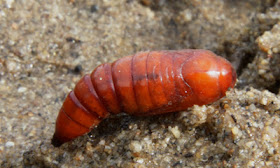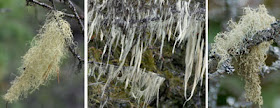Move over Sherlock Holmes! Our mystery has been solved. Lest we convicted a wrong guy.
Remember last year's post about Dogbane and the creatures that use its deadly sap for their protection?
Of course not but that's OK.
In that post I was milling about a handsome white caterpillar and the cocoon it it spun about ten days later.
We found the caterpillar on August 24. It was white, hairy and somehow forecasting a subtle message:
"Do Not Touch."
Or maybe it said: "Do Not Eat."
The birds certainly heeded the warning since the white one was freely roaming about, looking for a place of solace.
Who was it, we wondered, totally taken by its beauty and tickled by the subconscious thoughts of it perhaps stinging or even being poisonous.
By September 3rd, the caterpillar arranged for a wild haircut - all that remained was a soft-looking, somehow unrecognizable lump of cells wrapped in a mat of scary looking hair. Our caterpillar readied itself for the upcoming winter. And we still did not know who might emerge next spring.
Another ten days later, on September 13th, we found another caterpillar - same shape, same size, only its fur coat was yellow. Who was he in relation to the white one? A brother, uncle or a total stranger? We chose to believe that it belonged to the same family. But its name was still far from clear. This one too, crawled into a pile of vegetation to become a cocoon.
I am not sure what happened after. I believe that there was a huge reorganization inside of the hairy cocoon that resulted in a pupa - hard cased structure that would overwinter in soil. Inside it a creature much different from the caterpillar would patiently wait for the glorious days of Spring.
Now, imagine this: one day you go to bed and by the morning your body will have fallen into bits and pieces which will reorganize and rejoin in a totally different way. By itself! You will go to sleep being a crawling caterpillar and wake up being a flying moth. No waste. That's efficiency!
But I am getting ahead of this story.
Winter arrived and left.
It is end of May now and millions of things are happening all the time and all over the place.
The plants are sprouting and blooming, and with them a whole world of other creatures is rushing to commence and complete new cycles of life.
Just yesterday, I too was crawling in the grass trying to be artistic! That's what Spring does to everyone.
I was taking photos of a tiny chickweed flower.
(Chickweeds, Stellaria - So good for you - did you know?)
It looked so fancy through my macro lens that my mood shifted into a nostalgic mode
(it does not take much these days).
All I could think of was how many amazing things and creatures we go by every day without looking, without even knowing that they exist.
When I finally peeled my eyes off the viewfinder I was staring straight at another white creature that must have just emerged from the safety of soil; its whiteness so pure that it made me gasp in awe.
(I was in that nostalgic mood, remember?)
It sat there - hugging the grass stems, motionless - for quite a while, probably sensing all the Carbon dioxide given off by my body and flooding its space, cursing its bad luck.
(Insects and other creatures can tell the presence and size of another animal by the amount of CO2 that it exudes. That's why they wisely move off or move in - depending on their way of making a living.)
There was a lot of CO2 at the moment and even more poured out with my breath as I whispered a flurry of questions:
You? You were that caterpillar! Who are you? I think that you are a male.....but ... what's your name?
He should have answered:
Of course I am a male - I have big antennae which females do not posses. It is MY job to seek them out, not theirs to seek me. They only exude their perfumes, you know? And, by the way, my name is Yellow Wooly Bear Moth, Spilosoma virginica.
Nice to meet you!
But no!
All he would do for the moment was to sit there, feeling (instead of thinking):
"Dry fast my body! Pump air into those air tubes in my wings so this body can harden, the wings stiffen and carry me away from this gaseous heap!
I need to fly, flitter about, start looking for females (not this one though!).
I hope that I will not get squished soon.
I need to carry out my job - I have to mate!"
Not knowing his real name then, I named him Albert.
The reasoning for giving him that name is quite obvious: in its white lab coat and with a head full of untamed white hair, even with a hint of a bushy moustache, he made me think of Albert Einstein.
He also made me think of many unsolved secrets, of the processes that make his white body work, his ways of dealings with the world - so different from ours, his powers and his role in the interconnected world that we, humans, are only vaguely becoming to understand.
Finally! His wings spread wider and then wide until they were flat and ready. They started to vibrate in a very rapid sequence, his antennae perked up, one last breath and a clumsy take off. Airborne at last! By the time the sun sets he will be an expert flier. And then ......
Every moth-boy knows by default how to get a moth-chick. There are two ways:
The first way is kind of crude: one can patiently sit perched on vegetation, saving his energy for things to come. When a suitable moth-girl flies by, peacefully giving off her pheromonal perfume, he takes a sniff, takes off, forces her to the ground and .... is this legal? REALLY? Bully style?!?
The other, more caring way, is to fly about, seek the girls by tasting the air with the huge antennae and hone on closer and closer. Follow a bunch of irresistible pheromones, release some of own... and ... voila.
When done, go and seek another. Energy consuming?
Yes. but ... job is a job.....is.....a......job!
Albert is the caring kind - he will fly and seek and find his girls, his awesome antennae (which the bully guys do not posses) tasting and analyzing the air for molecules that came his way from miles and miles away. He will not eat or drink; just fly ceaselessly, using the fatty reserves of his strong, handsome body. He will father several families before his time is up. Then, before the summer arrives he will die. But the summer generation(s) (some say one and some say two) will progress towards the Fall. His offspring will gorge on dogbane and milkweed and other horribly tasting and poisonous plants that could harm me and you but not them. So the birds and mice and skunks will leave them alone allowing them to make a bed in the cold October soil., ..... -
......and the cycle will repeat itself as it has so many times.
Good luck Albert - fly well! I am glad we've met.

















.jpg)



















